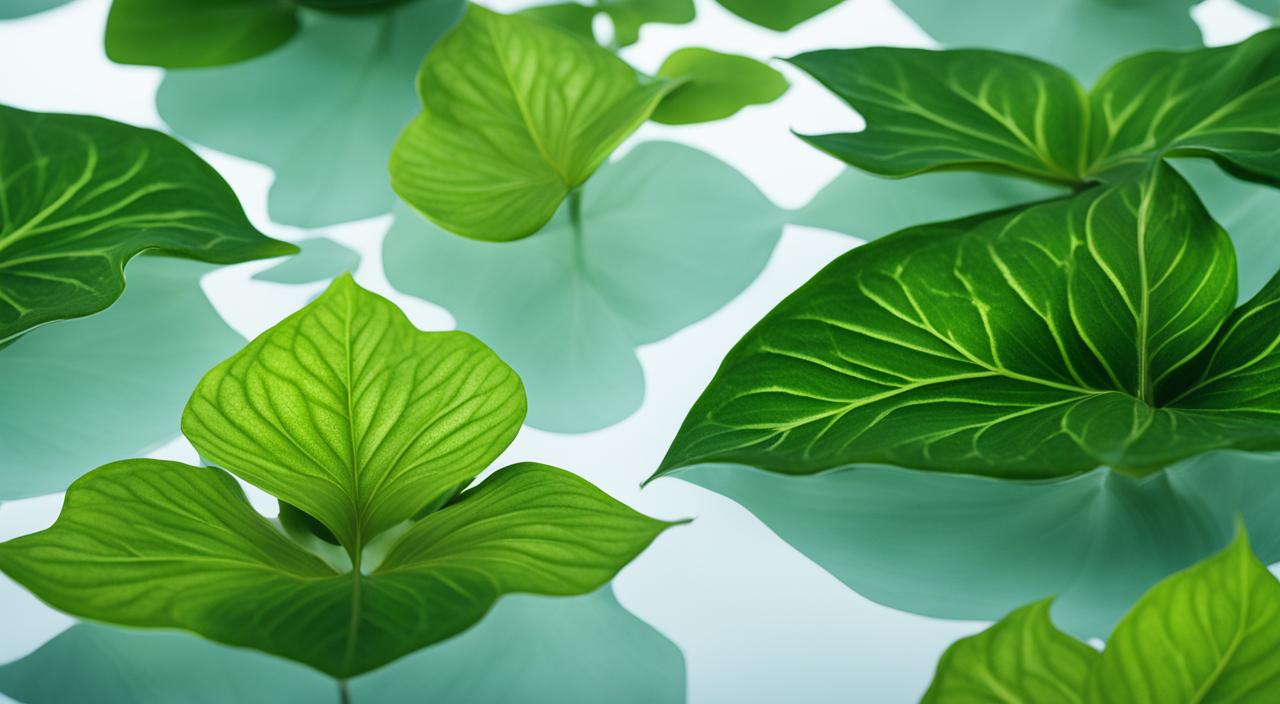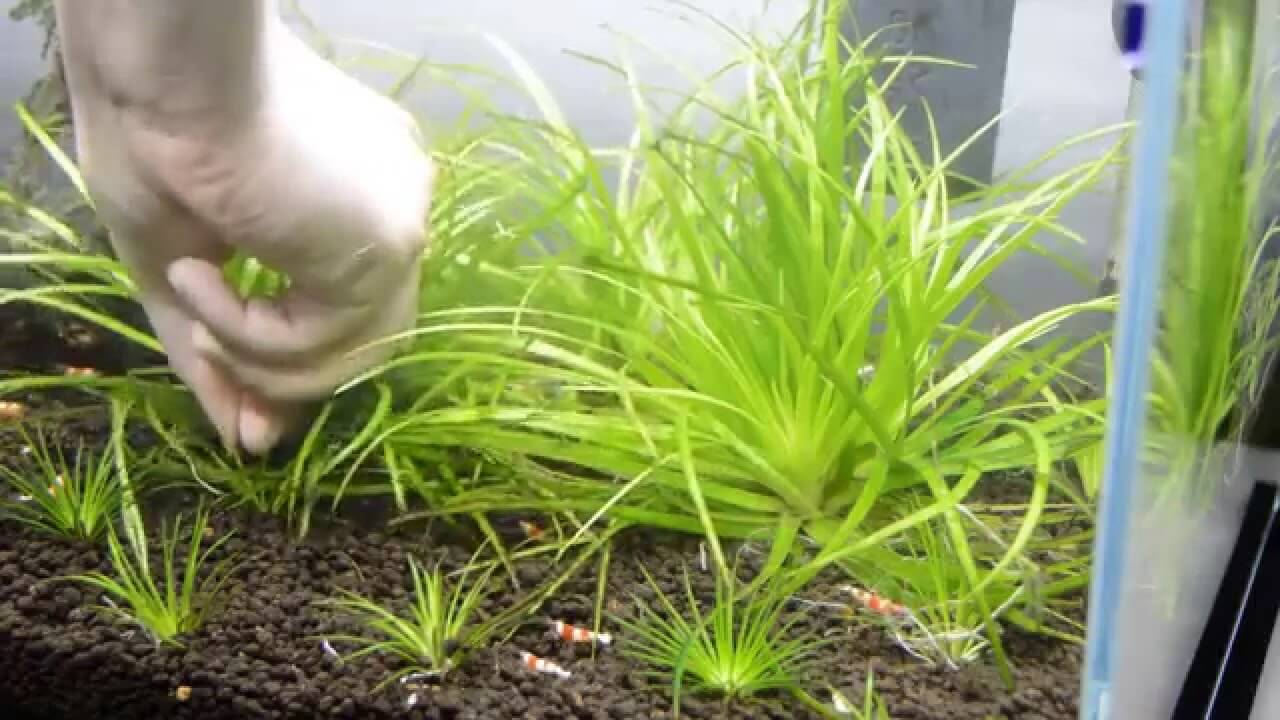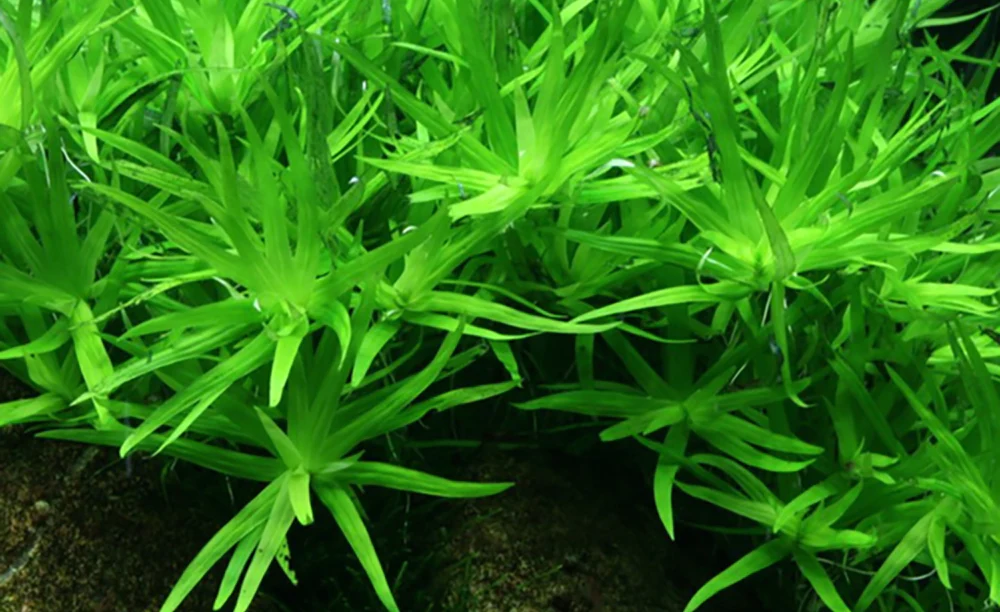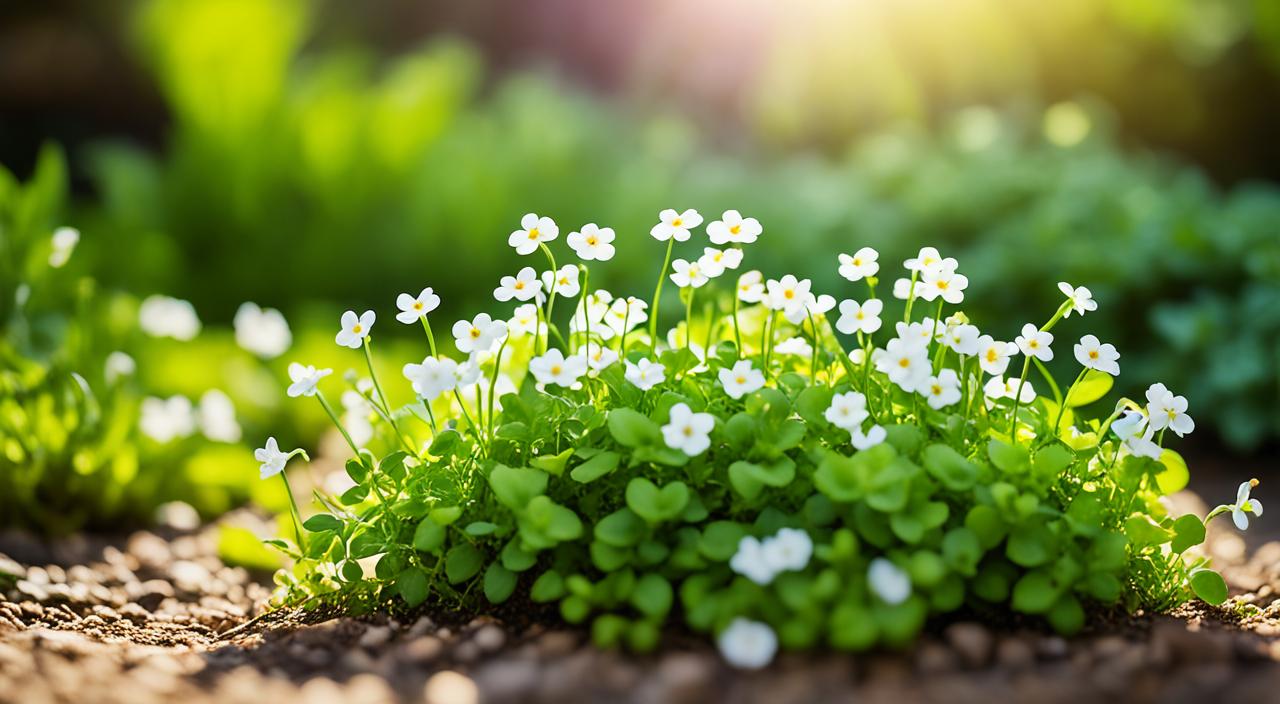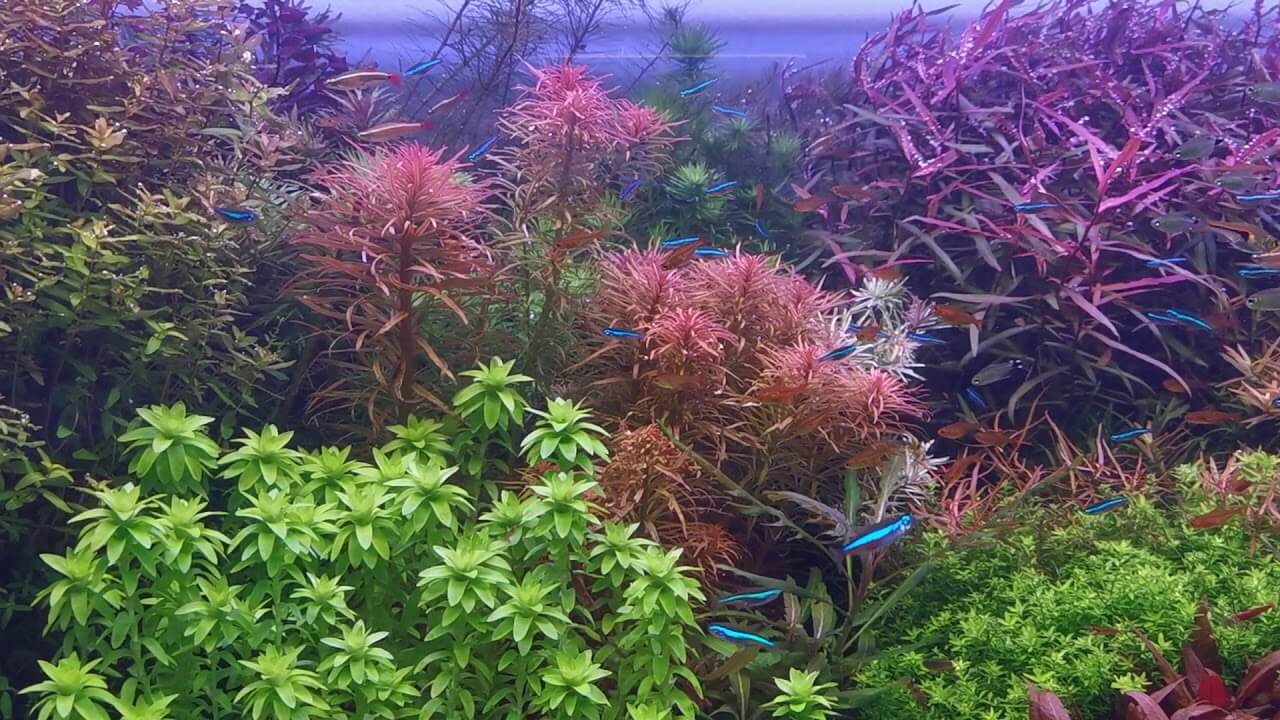Greetings, aquarium enthusiasts! This article will provide a comprehensive guide to caring for and maintaining Anubias Barteri, a versatile and hardy aquatic plant. Whether you are a beginner or an experienced aquarist, Anubias Barteri is an excellent choice for freshwater aquascaping.
Anubias Barteri is highly regarded for its ability to thrive in low light conditions, making it perfect for aquariums with limited or no access to natural sunlight. Its beautiful and vibrant green leaves make it an attractive addition to any aquascape.
Join me as we explore the origins, habitat, morphological characteristics, placement and lighting requirements, ideal tank mates, feeding and fertilization, CO2 injection, plant care, aquarium maintenance, health and disease, and summarize key points of Anubias Barteri care.
Key Takeaways:
- Anubias Barteri is a versatile, hardy aquatic plant ideal for low-light aquarium setups.
- It originates from West Africa and grows along riverbanks and streams.
- Anubias Barteri has a unique morphology characterized by a rhizome from which its broad and durable leaves grow.
- It thrives in low to medium light conditions and should be placed in the midground or background of your aquarium.
- Anubias Barteri is compatible with peaceful community fish, shrimp, and snails but avoids aggressive or herbivorous species.
Brief Overview Of Anubias Barteri
Anubias Barteri is a popular aquatic plant from the Araceae family and native to West Africa. It is known for its slow-growing nature, making it a great addition to any aquarium. This plant can reach a height of 4-6 inches and has broad, durable leaves that can grow up to 3 inches long.
Anubias Barteri Species Table:
| Characteristic | Description |
|---|---|
| Scientific Name: | Anubias barteri |
| Common Names: | Anubias, Barteri, Anubias Barteri |
| Origin: | West Africa |
| Height: | 15-40 cm |
| Growth Rate: | Slow |
| Colour: | Dark green leaves |
| Aquarium Placement: | Midground to background, attached to hardscape (rocks, driftwood) |
| Water Type: | Freshwater |
| pH: | 6.0 – 7.5 |
| Care Level: | Easy |
| Light Requirements: | Low to moderate; 50-200 PAR, 2000-3000 lux, Kelvin scale 5000K-7000K for optimal growth |
| CO2 Requirements: | Primarily photosynthetic; benefits from micronutrient fertilizers, especially if not planted in substrate |
| Temperature: | 22°C – 28°C (72°F – 82°F) |
| Flow Rate: | Low to moderate; can tolerate higher flow if not directly exposed |
| Propagation: | Primarily photosynthetic; benefits from micronutrient fertilizers, especially if not planted in the substrate |
| Feed Type: | Rhizome division or separating side shoots |
Several varieties of Anubias Barteri are available, each with its unique characteristics. These varieties include Anubias Barteri var. barteri, Anubias Barteri var. round leaf, Anubias Barteri var. broad leaf, Anubias Barteri var. glabra, and Anubias Barteri var. caladiifolia. While these varieties differ slightly in leaf shape and size, they all share the exact slow-growing, hardy nature.
Anubias Barteri is particularly popular among beginners due to its ease of care. It can withstand a variety of water conditions and can thrive in both low-light and medium-light setups. Its versatility and hardiness make it an excellent choice for aquarists looking to add a touch of greenery to their aquariums.
| Variety | Leaf shape | Leaf size |
|---|---|---|
| Anubias Barteri var. barteri | Narrow | Medium |
| Anubias Barteri var. round leaf | Round | Small |
| Anubias Barteri var. broad leaf | Broad | Large |
| Anubias Barteri var. glabra | Narrow | Medium |
| Anubias Barteri var. caladiifolia | Narrow | Large |
Origins And Habitat
Anubias Barteri, a versatile aquatic plant, originates from West Africa, specifically countries like Nigeria, Cameroon, and Gabon. In its native habitat, Anubias Barteri is typically found along riverbanks and streams, where it attaches itself to rocks or driftwood. This plant has adapted to thrive in low-light conditions and can grow in shaded areas. During the rainy season, Anubias Barteri is submerged in water, and it can withstand dry periods during the dry season.
In aquariums, Anubias Barteri can be cultivated either submerged or emersed. It is commonly used in biotope aquarium setups to replicate the natural habitat of West Africa, providing an authentic and captivating aquatic environment.
Morphological Characteristics
Anubias Barteri, a versatile and hardy aquatic plant, exhibits unique morphological characteristics that contribute to its appeal and resilience in aquarium settings. One notable feature is its rhizome, a thick horizontal stem that stores nutrients and anchors the substrate or attachment surface. From the rhizome, leaves and roots emerge, enhancing the plant’s overall structure.
The leaves of Anubias Barteri are broad, durable, and possess a leathery texture, making them resistant to damage and herbivores. These robust leaves also discourage algae growth, maintaining the plant’s aesthetic appeal. With their deep green colouration, the leaves of Anubias Barteri provide a visually pleasing element to any aquarium.
It is worth noting that Anubias Barteri can produce flowers when grown emersed, although this occurrence is less common in submerged conditions. The flowers add a touch of beauty to the plant, showcasing its full potential.
Note:
The image below showcases the vibrant green leaves of Anubias Barteri, highlighting its attractive morphology.
Placement and Lighting
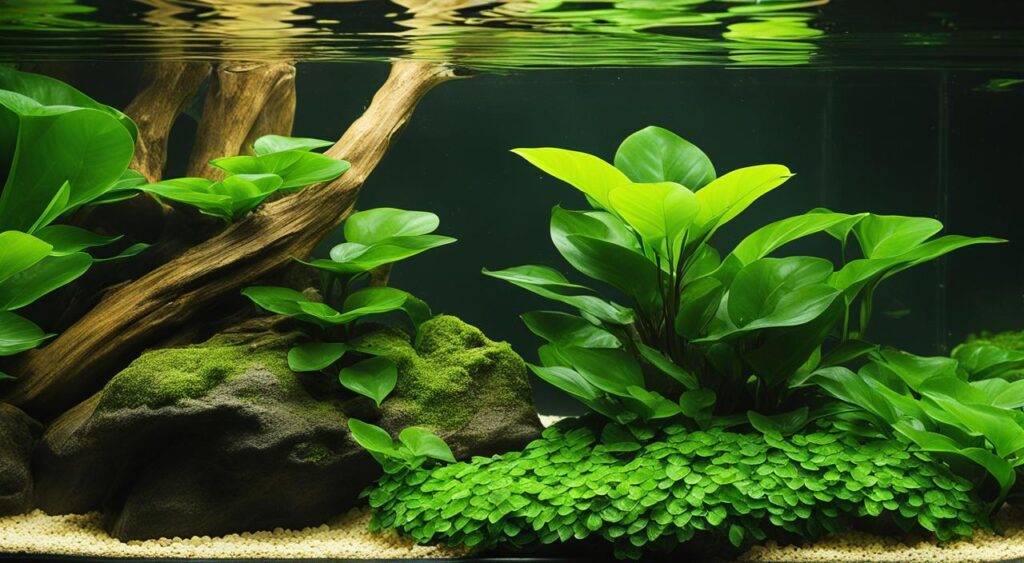
Anubias Barteri is a versatile aquatic plant that can be placed in various locations within an aquarium. Its adaptability complements different tank scapes and layouts, adding beauty and visual interest to any marine environment.
When considering the placement of Anubias Barteri, it is crucial to consider its lighting requirements. This plant thrives in low to medium light conditions, making it an excellent choice for aquariums with limited lighting options. Its ability to succeed in low-light conditions makes it a popular choice for low-light aquarium setups.
Too much light can cause excessive algae growth on the leaves of Anubias Barteri, which can negatively impact its health and appearance. To prevent this, it is essential to provide shading or moderate lighting levels. This can be achieved by placing the plant in aquarium areas with indirect lighting or using floating plants or other structures to create shade.
In addition to artificial lighting, Anubias Barteri can benefit from natural sunlight if provided in moderation. Placing the aquarium near a window or using full spectrum lights can help provide the plant with the necessary light for growth and development.
| Placement Tips | Lighting Recommendations |
|---|---|
| Midground and background areas of the aquarium | Low to medium light conditions |
| Consider the tank scape and layout for aesthetic appeal | Provide shading or moderate lighting levels |
| Utilize natural sunlight in moderation | Avoid excessive lighting to prevent algae growth |
What Are Good Tank Mates?
Anubias Barteri is a versatile and hardy plant that can thrive alongside many aquarium fish and invertebrates as tank mates. It provides a hiding place and shelter for small fish and fry, creating a harmonious and natural environment. When choosing tank mates for Anubias Barteri, it is essential to consider their compatibility and behaviour to ensure the well-being of the plant and the other aquarium inhabitants.
Good Tank Mates
Several peaceful community fish species make excellent tank mates for Anubias Barteri. These include tetras, such as Neon Tetras (Paracheirodon innesi); Rasboras, like Harlequin Rasboras (Trigonostigma heteromorpha); livebearers, such as Guppies (Poecilia reticulata) and Dwarf Cichlids like Apistogramma species. These fish are known for their peaceful behaviour and are less likely to disturb or damage the leaves of Anubias Barteri.
In addition to fish, Anubias Barteri can also coexist with shrimp and snails. Cherry Shrimp (Neocaridina davidi) and Amano Shrimp (Caridina multidentata) are popular choices, as they can help control algae growth and provide additional interest to the tank. Nerite Snails (Neritina natalensis) and Mystery Snails (Pomacea bridgesii), can also be compatible tank mates for Anubias Barteri as they contribute to the overall ecosystem and help with cleaning.
Fish Species To Avoid
While Anubias Barteri is generally compatible with a wide range of tank mates, avoiding aggressive or herbivorous fish species that may damage or consume the plant leaves is essential. Aggressive fish can nip at the leaves, leading to torn or tattered foliage. Herbivorous fish may eat the leaves, inhibiting the growth and vitality of Anubias Barteri. Some species to avoid as tank mates for Anubias Barteri include larger cichlids, such as Oscar Fish (Astronotus ocellatus), aggressive barbs like Tiger Barbs (Puntius tetrazona), and herbivorous species like Silver Dollars (Metynnis species).
When selecting tank mates for Anubias Barteri, it is essential to consider the compatibility and needs of the different species to maintain a harmonious and thriving aquarium ecosystem. Choosing suitable tank mates allows you to create a beautiful and balanced underwater world.
Feeding (Fertilization)
How Much And How Often To Feed
Anubias Barteri is not a heavy feeder and can obtain nutrients from the water column and substrate. However, providing additional fertilization can promote healthier growth and prevent nutrient deficiencies. Liquid fertilizers formulated explicitly for aquarium plants can supplement the nutrient requirements of Anubias Barteri. It is essential to follow the manufacturer’s instructions regarding the dosage and frequency of fertilization. Over-fertilization can lead to algae problems, so it is necessary to maintain a balanced nutrient level.
CO2 Injection
Anubias Barteri can grow well without CO2 injection, as it can absorb carbon dioxide from the surrounding water. However, providing CO2 supplementation can enhance the growth and development of Anubias Barteri, particularly in high-light setups.
Types
There are different types of CO2 injection methods available for aquariums:
- Pressurized CO2 Systems: These systems use a pressurized CO2 cylinder connected to a regulator and diffuser. The CO2 is released into the aquarium in controlled amounts, ensuring plants like Anubias Barteri can access the necessary carbon dioxide for photosynthesis.
- DIY CO2 Setups: For those on a budget or looking for a DIY option, DIY CO2 setups can be created using commonly available materials. These setups typically involve using yeast and sugar to produce carbon dioxide, which is then diffused into the aquarium. While DIY CO2 setups may not provide carbon dioxide levels as consistent or precise as pressurized systems, they can still be effective for enhancing plant growth.
- Liquid Carbon Supplements: Liquid carbon supplements can also provide a source of carbon dioxide for plants like Anubias Barteri. These supplements typically contain compounds like glutaraldehyde, which plants can utilize as a carbon source. Liquid carbon supplements are easy to dose and can be a convenient alternative to other CO2 injection methods.
When considering CO2 injection for Anubias Barteri, it is essential to evaluate your aquarium’s specific needs and the plants’ desired growth rate. Monitoring and adjusting carbon dioxide levels accordingly can help promote optimal growth and vitality.
Care
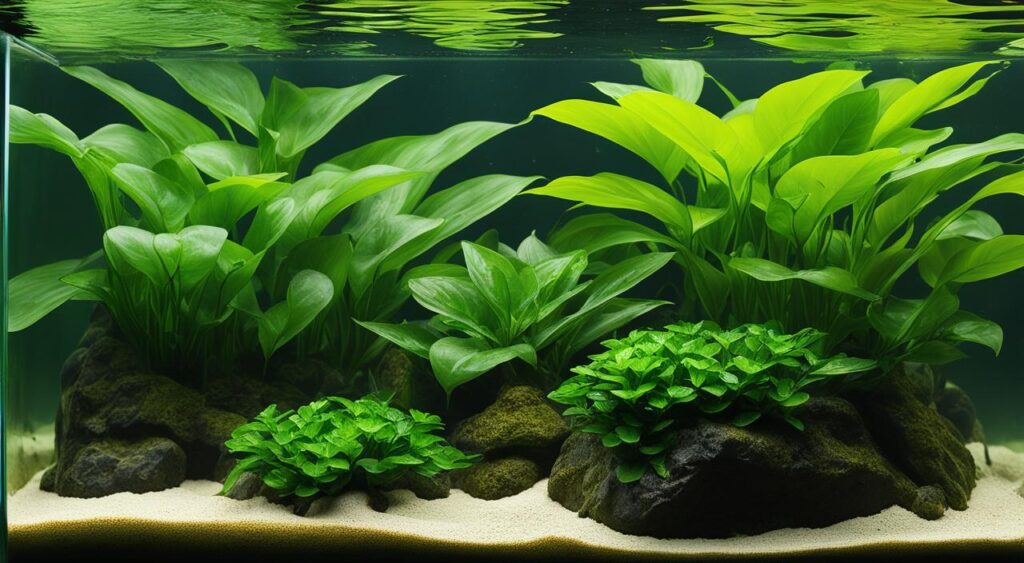
Planted Tank Parameters
Proper care is crucial for the healthy growth of Anubias Barteri in an aquarium. One of the essential aspects of care is maintaining appropriate planted tank parameters. Anubias Barteri can tolerate a wide range of water parameters, but it thrives in slightly acidic to neutral pH (6-7.5) and 72-78 degrees Fahrenheit water temperatures.
Water Quality
Ensuring good water quality is fundamental for the well-being of Anubias Barteri. It is essential to test the water regularly to monitor pH, ammonia, nitrite, and nitrate levels. Anubias Barteri can tolerate certain compounds, but excessively high levels can harm its health. Regular water changes and a reliable water conditioner can help maintain optimal water quality.
Filtration
Providing efficient filtration is crucial for the health of Anubias Barteri. A proper filtration system helps remove debris, excess waste, and harmful substances from the water, ensuring a clean and stable environment for the plant. It is recommended to use a filter that provides mechanical, chemical, and biological filtration for maximum effectiveness.
Flow
Maintaining proper water flow is essential for Anubias Barteri. Gentle water flow helps distribute nutrients and oxygen evenly throughout the tank, promoting healthy growth. However, excessive water flow can cause stress to the plant and potentially damage its leaves. Aim for a moderate and consistent water flow that suits the needs of Anubias Barteri and other inhabitants in the aquarium.
| Planted Tank Parameters | Water Quality | Filtration | Flow |
|---|---|---|---|
| Anubias Barteri thrives in slightly acidic to neutral pH (6-7.5) and water temperatures of 72-78 degrees Fahrenheit. | Anubias Barteri thrives in slightly acidic to neutral pH (6-7.5) and 72-78 degrees Fahrenheit water temperatures. | An efficient filtration system that provides mechanical, chemical, and biological filtration helps keep the water clean and free from harmful substances. | Moderate and consistent water flow is ideal for Anubias Barteri to ensure proper nutrient distribution and prevent stress. |
Aquarium Maintenance
Testing Water Conditions
Regularly testing the water conditions in your aquarium is essential for maintaining the health and vitality of Anubias Barteri. Monitoring pH, ammonia, nitrite, and nitrate levels helps ensure a stable and suitable environment for the plant to thrive.
Testing kits are readily available and easy to use, providing accurate readings of the water parameters. Testing the water weekly or as needed to address any potential issues promptly is recommended.
How To Set Up Your Aquarium Tank
Properly setting up your aquarium tank is crucial for the successful growth of Anubias Barteri. Key factors to consider include substrate choice, lighting, and filtration.
When selecting a substrate, choose a fine-grained material that allows for adequate root development and nutrient absorption. Ensure the substrate is thoroughly rinsed before placing it in the tank to remove debris or contaminants.
For lighting, Anubias Barteri thrives in low to medium light conditions. Use aquarium lights designed explicitly for planted tanks to provide the appropriate spectrum and intensity. Avoid placing the lights too close to the plant to prevent excessive algae growth.
Efficient filtration is essential to maintain water quality and remove waste and toxins. Install a filter system suitable for the size of your tank to ensure proper circulation and oxygenation.
Propagation Methods
Knowing the various propagation methods for Anubias Barteri allows you to expand your plant collection and maintain its aesthetics. Two standard methods of propagation are rhizome division and leaf cuttings.
Rhizome division involves separating the rhizome into individual sections, ensuring that each section has healthy roots and leaves. Plant the divided sections in separate areas of the tank or in other tanks to encourage new growth.
Leaf cuttings can be taken by carefully cutting a healthy leaf from the plant and planting it in the substrate. Ensure that a portion of the leaf is submerged in the substrate while the rest remains above the water surface.
Both methods require proper care and patience to allow the new plants to establish themselves and develop into mature specimens.
| Testing Water Conditions | How To Set Up Your Aquarium Tank | Propagation Methods |
|---|---|---|
| Regular water testing | Choose suitable substrate | Rhizome division |
| Monitor pH, ammonia, nitrite, and nitrate levels | Use appropriate lighting | Leaf cuttings |
| Address water parameter issues promptly | Install efficient filtration system |
Health And Disease
Maintaining the health of Anubias Barteri involves being attentive to signs of good health and promptly addressing any signs of poor health. By ensuring the well-being of your Anubias Barteri, you can enjoy its beauty and contribute to a thriving aquatic environment.
Signs Of Good Health
Signs of good health in Anubias Barteri include vibrant green leaves, strong rhizome growth, and the absence of discolouration or damage. Healthy Anubias Barteri plants exhibit robust foliage, indicating a well-established root system and efficient nutrient absorption.
Signs Of Poor Health
Signs of poor health in Anubias Barteri may manifest as yellowing or browning leaves, weak or rotting rhizomes, or the presence of algae or pests. These indicators can indicate nutrient deficiencies, fungal infections, or infestations that require immediate attention to prevent further damage.
Common Health Issues And Treatment
Common health issues that affect Anubias Barteri include nutrient deficiencies, fungal infections, and infestations by snails or algae. Nutrient deficiencies can be addressed through proper fertilization and balancing the water parameters. Fungal infections may require antifungal treatments, whereas infestations can be controlled through manual removal or the introduction of appropriate fish or invertebrate species.
Plant Pests
Anubias Barteri is susceptible to various pests, including snails, algae, and other invertebrates. Snails can damage the leaves and hinder growth, while algae can compete with the plant for nutrients and light. Monitoring and controlling the pest population is crucial to prevent damage to Anubias Barteri. Regular cleaning and maintenance, manual removal, and algae-controlling methods can help keep pests under control and maintain the plant’s health.
Summary of Health And Disease
| Signs of Good Health | Signs of Poor Health | Common Health Issues and Treatment | Plant Pests |
|---|---|---|---|
| Vibrant green leaves | Yellowing or browning leaves | Nutrient deficiencies, fungal infections, and infestations | Snails, algae, and other invertebrates |
| Strong rhizome growth | Weak or rotting rhizomes | Antifungal treatments, manual removal, and introduction of appropriate species | |
| Absence of discoloration or damage | Presence of algae |
Summary
Anubias Barteri is a versatile and hardy plant that can be a valuable addition to any aquarium. Its low light requirements, ease of care, and attractive appearance make it popular for aquarists of all experience levels.
Understanding the origins, habitat, morphological characteristics, and care requirements of Anubias Barteri is crucial for successful cultivation and maintenance. This plant is native to West Africa and is typically found along riverbanks and streams, attached to rocks or driftwood. It possesses a unique morphology with a thick rhizome from which its broad, durable leaves grow.
Placement and lighting are critical factors in ensuring the well-being of Anubias Barteri. It thrives in low to medium-light conditions and can be placed in various locations within an aquarium. Additionally, selecting suitable tank mates, providing proper feeding and fertilization, and considering CO2 injection are essential aspects of caring for this plant.
Regular aquarium maintenance, testing water conditions, setting up the tank correctly, and understanding propagation methods are essential for the overall health and vitality of Anubias Barteri. It is also crucial to monitor its health, promptly address any signs of poor health, and prevent common issues such as nutrient deficiencies and pest infestations. With proper care, Anubias Barteri can enhance the beauty and health of your aquatic environment.
FAQ
What is Anubias Barteri?
Anubias Barteri is a popular low light aquatic plant that is frequently used in aquariums for aquascaping. It is known for its versatility and hardiness, making it an excellent choice for both beginners and experienced aquarists.
Where is Anubias Barteri native to?
Anubias Barteri is native to West Africa, specifically countries such as Nigeria, Cameroon, and Gabon. It is typically found growing along riverbanks and streams, attached to rocks or driftwood.
What are the different varieties of Anubias Barteri?
There are several varieties of Anubias Barteri available, including Anubias Barteri var. barteri, Anubias Barteri var. round leaf, Anubias Barteri var. broad leaf, Anubias Barteri var. glabra, and Anubias Barteri var. caladiifolia. These varieties differ slightly in leaf shape and size.
Where should I place Anubias Barteri in my aquarium?
Anubias Barteri can be placed in various locations within an aquarium, including the midground and background. Its versatility allows it to adapt to different tank scapes and layouts. It thrives in low to medium light conditions.
What are good tank mates for Anubias Barteri?
Anubias Barteri is compatible with a wide range of aquarium fish and invertebrates. Some suitable tank mates include peaceful community fish such as tetras, rasboras, livebearers, and dwarf cichlids. It can also coexist with shrimp and snails.
How often should I fertilize Anubias Barteri?
Anubias Barteri is not a heavy feeder and can obtain nutrients from the water column and substrate. However, providing additional fertilization can promote healthier growth. Follow the manufacturer’s instructions regarding the dosage and frequency of fertilization.
Do I need to inject CO2 for Anubias Barteri?
Anubias Barteri can grow well without CO2 injection, as it can absorb carbon dioxide from the surrounding water. However, providing CO2 supplementation can enhance its growth and development, especially in high light setups.
What are the care requirements for Anubias Barteri?
Anubias Barteri thrives in slightly acidic to neutral pH (6-7.5) and water temperatures of 72-78 degrees Fahrenheit. It can tolerate a wide range of water parameters, but sudden changes should be avoided. Proper maintenance, including regular testing of water conditions, is important.
How do I propagate Anubias Barteri?
Anubias Barteri can be propagated through methods such as rhizome division and leaf cuttings. These methods allow you to expand your plant collection and maintain its aesthetics.
What are the common health issues and treatments for Anubias Barteri?
Common health issues for Anubias Barteri can include nutrient deficiencies, fungal infections, and infestations by snails or algae. Prompt treatment and prevention measures can help preserve the health of the plant.

